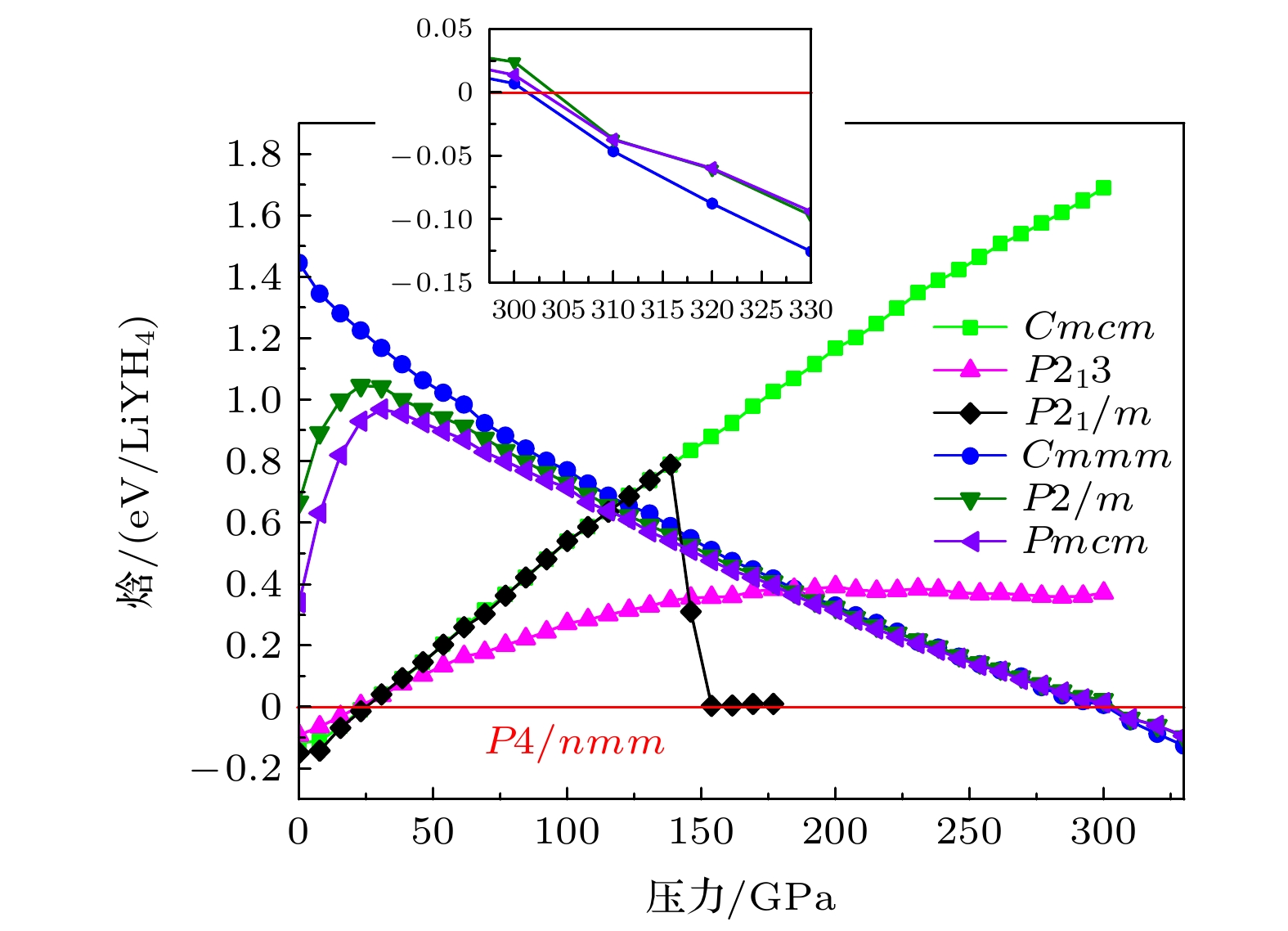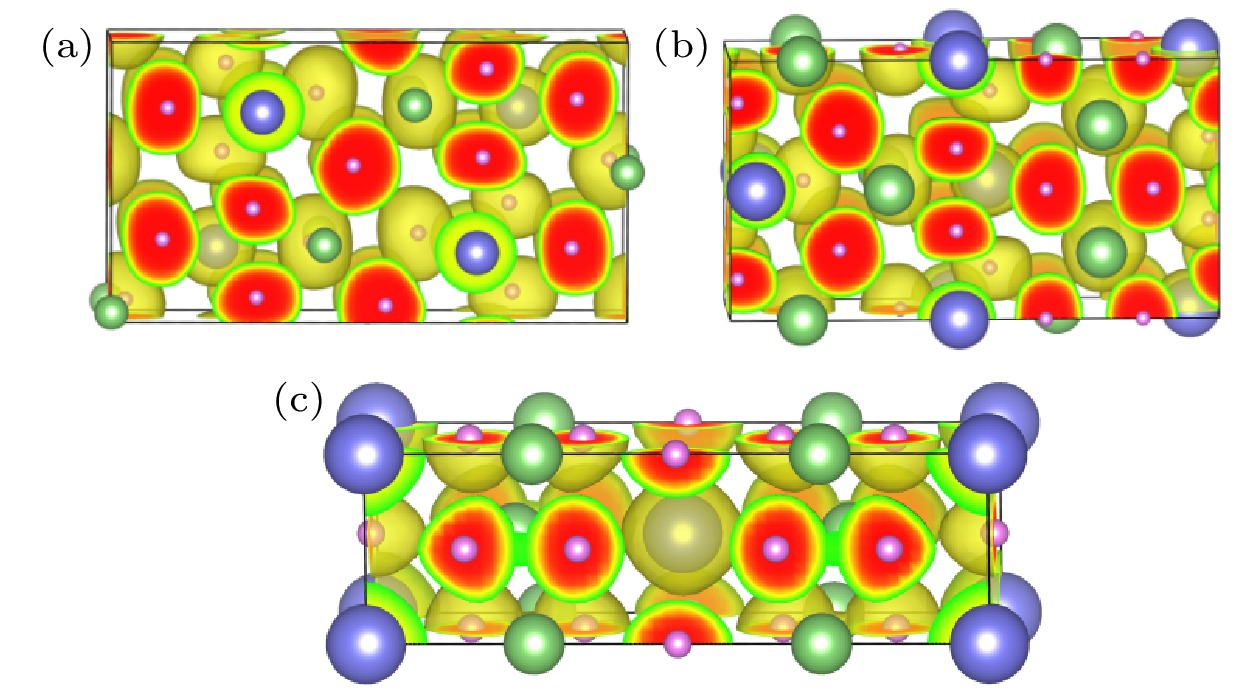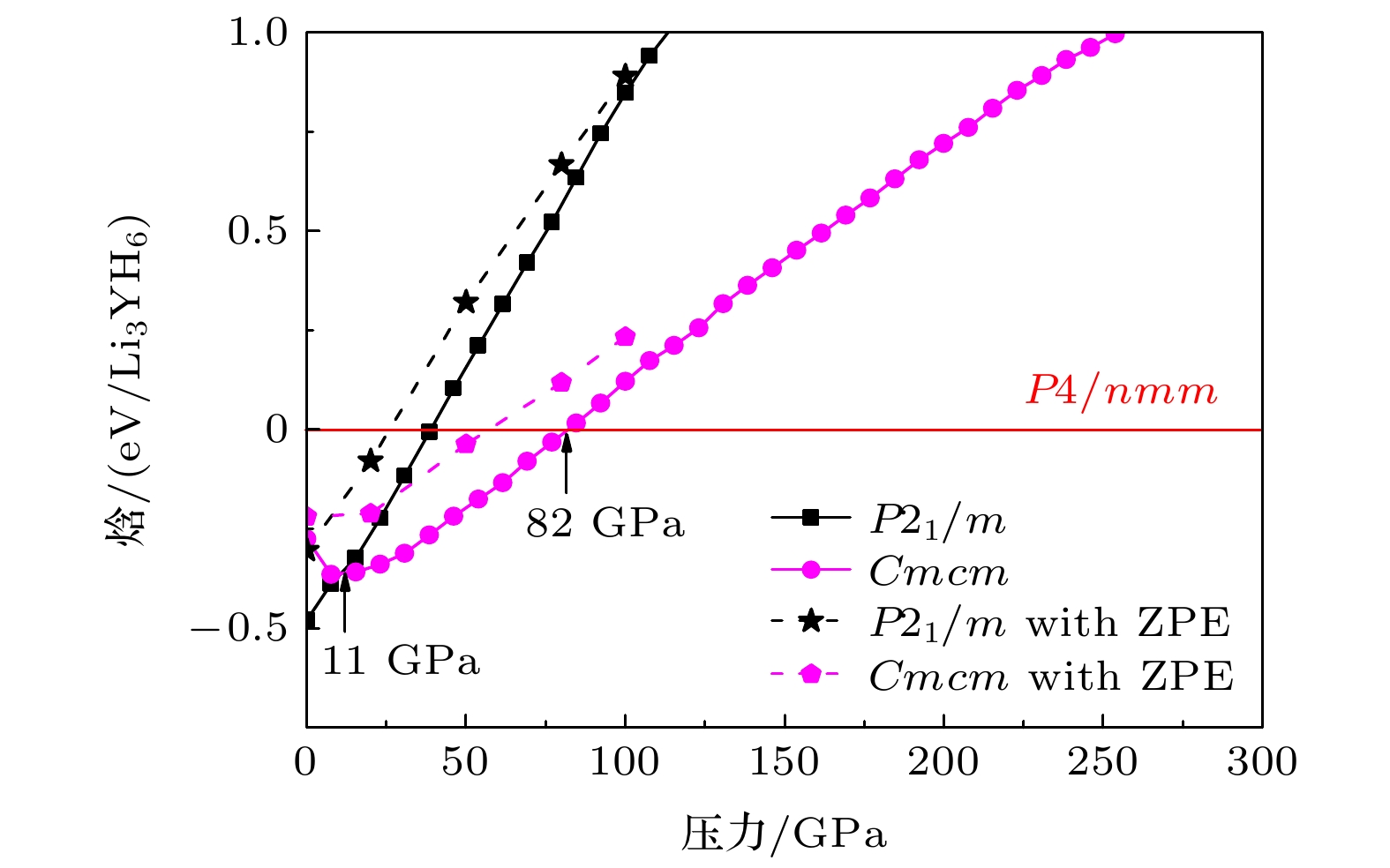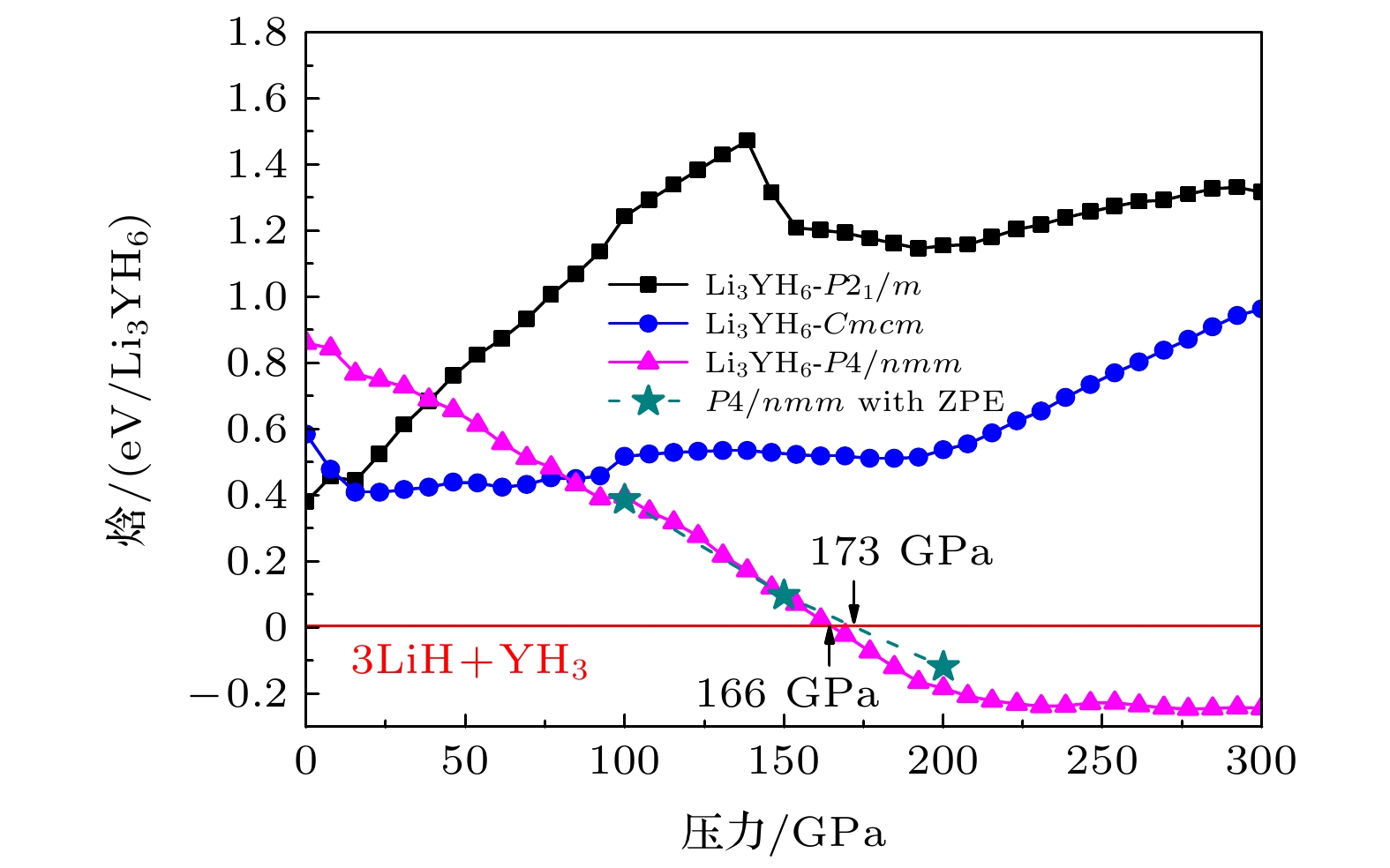-
本文基于粒子群优化算法的结构预测方法结合第一性原理计算, 研究了LiYH4, Li2YH5和Li3YH6在0—300 GPa压力范围内的晶体结构、电子结构、热力学和动力学稳定性. 研究结果表明LiYH4-P4/nmm, Li2YH5-I4/mmm和Li3YH6-P4/nmm结构可分别在169—221 GPa, 141—300 GPa和166—300 GPa压力范围内由LiH和YH3按一定配比加压合成. 富氢化合物的超导电性研究成为近年来高温超导体研究领域的热点, 该研究结果有希望为Li-Y-H三元体系氢化物的超导电性研究及实验合成提供数据支撑.The research on the superconductivity of hydrogen-rich compounds has become a hot research topic in the field of high-temperature superconductors in recent years and yttrium hydride YH9+x has been experimentally confirmed to have high temperature superconductivity (near room temperature (Tc = 262 K)), following behind the research of H3S (Tc = 200 K) and LaH10 (Tc = 260 K). The theoretical study of binary hydrogen-rich systems is relatively mature, while the structural characteristics and superconductivity of ternary or quaternary hydrogen-rich compounds are still under exploration. In this paper, nLiH + YH3→LinYHn+3 (n = 1–3) is the synthesis way to explore the stable configuration of ternary hydride LinYHn+3 in a pressure range of 0–300 GPa. The crystal structure, electronic structure, thermodynamic and kinetic stability of LiYH4, Li2YH5 and Li3YH6 in the pressure range of 0–300 GPa are studied based on the structure prediction by particle swarm optimization algorithm and first-principles calculation. The CALYPSO method is used to search for 1–4 times molecular formula structures for Li-Y-H ternary systems with different stoichiometric ratios in the pressure range of 0–300 GPa in steps of 50 GPa. The results show that LiYH4-P4/nmm, Li2YH5-I4/mmm, and Li3YH6-P4/nmm can be respectively synthesized with a certain ratio between LiH and YH3 respectively in a pressure range of 169–221 GPa, 141–300 GPa and 166–300 GPa. The Li2YH5 has the lowest stable pressure and widest range which can be the possible choice in experiment. The results can provide the data support for the superconductivity research and experimental synthesis of hydrides in Li-Y-H ternary system.
-
Keywords:
- ternary hydride /
- Li-Y-H /
- structure prediction /
- first-principles research
[1] Ashcroft N W 2004 Phys. Rev. Lett. 92 187002
 Google Scholar
Google Scholar
[2] Shamp A, Zurek E 2017 Nov. Supercond. Mater. 3 14
 Google Scholar
Google Scholar
[3] Eremets M I, Trojan I A, Medvedev S A, Tse J S, Yao Y 2008 Science 319 1509
 Google Scholar
Google Scholar
[4] Zurek E, Hoffmann R, Ashcroft N W, Oganov A R, Lyakhov A O 2009 Proc. Natl. Acad. Sci. U S A. 106 17640
 Google Scholar
Google Scholar
[5] 孙莹, 刘寒雨, 马琰铭 2021 70 017407
 Google Scholar
Google Scholar
Sun Y, Liu H Y, Ma Y M 2021 Acta Phys. Sin. 70 017407
 Google Scholar
Google Scholar
[6] Bi T, Zarifi N, Terpstra T, Zurek E 2019 Reference Module in Chemistry, Molecular Science and Chemical Engineering
[7] Drozdov A P, Eremets M I, Troyan I A, Ksenofontov V, Shylin S I 2015 Nature 525 73
 Google Scholar
Google Scholar
[8] Peng F, Sun Y, Pickard C J, Needs R J, Wu Q, Ma Y M 2017 Phys. Rev. Lett. 119 107001
 Google Scholar
Google Scholar
[9] Liu H Y, Naumov I I, Hoffmann R, Ashcroft N W, Hemley R J 2017 Proc Natl Acad Sci U S A. 114 6990
 Google Scholar
Google Scholar
[10] Somayazulu M, Ahart M, Mishra A K, Geballe Z M, Baldini M, Meng Y, Struzhkin V V, Hemley R J 2019 Phys. Rev. Lett. 122 027001
 Google Scholar
Google Scholar
[11] Wang C Z, Yi S, Cho J H 2019 Phys. Rev. B 100 060502
 Google Scholar
Google Scholar
[12] Kong P P, Minkov V S, Kuzovnikov M A, Besedin S P, Drozdov A P, Mozaffari S, Balicas L, Balakirev F F, Prakapenka V B, Greenberg E, Knyazev D A, Eremets M I 2019 arXiv: 1909.10482
[13] Snider E, Dasenbrock-Gammon N, McBride R, Wang X Y, Meyers N, Lawler K V, Zurek E, Salamat A, Dias R P 2021 Phys. Rev. Lett. 126 117003
 Google Scholar
Google Scholar
[14] Sun Y, Lv J, Xie Y, Liu H Y, Ma Y M 2019 Phys. Rev. Lett. 123 097001
 Google Scholar
Google Scholar
[15] 孙莹 2020 博士学位论文 (吉林: 吉林大学)
Sun Y 2020 Ph. D. Dissertation (Jilin: Jilin University) (in Chinese)
[16] Grishakov K S, Degtyarenko N N, Mazur E A 2019 J. Exp. Theor. Phys. 128 105
 Google Scholar
Google Scholar
[17] Li Y W, Hao J, Liu H Y, Tse J S, Wang Y C, Ma Y M 2015 Sci. Rep. 5 9948
 Google Scholar
Google Scholar
[18] Wang Y C, Lv J, Zhu L, Ma Y M 2012 Comput. Phys. Commun. 183 2063
 Google Scholar
Google Scholar
[19] Wang Y C, Lv J, Zhu L, Ma Y M 2010 Phys. Rev. B 82 094116
 Google Scholar
Google Scholar
[20] Gao B, Gao P Y, Lu S H, Lv J, Wang Y C, Ma Y M 2019 Sci. Bull. 064 301
 Google Scholar
Google Scholar
[21] Kresse G G, Furthmuller J 1996 Phys. Rev. B 54 11169
 Google Scholar
Google Scholar
[22] Perdew J P, Wang Y 1992 Phys. Rev. B 46 12947
 Google Scholar
Google Scholar
[23] Perdew J P, Burke K, Ernzerhof M 1996 Phys. Rev. Lett. 77 3865
 Google Scholar
Google Scholar
[24] Becke A D, Edgecombe K E 1990 J. Chem. Phys. 92 5397
 Google Scholar
Google Scholar
[25] Tang W, Sanville E, Henkelman G 2009 J. Phys.: Condens. Matter 21 084204
 Google Scholar
Google Scholar
[26] Bader R F W 1985 Acc. Chem. Res. 18 9
 Google Scholar
Google Scholar
[27] Henkelman G, Arnaldsson A, Jonsson H 2006 Comput. Mater. Sci. 36 354
 Google Scholar
Google Scholar
[28] Togo A, Oba F, Tanaka I 2008 Phys. Rev. B 78 134106
 Google Scholar
Google Scholar
[29] Giannozzi P, Baroni S, Bonini N, Calandra M, Car R, Cavazzoni C, Ceresoli D, Chiarotti G L, Cococcioni M, Dabo I 2009 J. Phys.: Condens. Matter. 21 395502
 Google Scholar
Google Scholar
[30] Liu L L, Sun H J, Wang C Z, Lu W C 2017 J. Phys.: Condens. Matter 29 325401
 Google Scholar
Google Scholar
[31] Dias R P, Silvera I F 2017 Science 355 715
 Google Scholar
Google Scholar
[32] Mcmahon J M, Ceperley D M 2011 Phys. Rev. Lett. 106 165302
 Google Scholar
Google Scholar
-
图 2 LiYH4的晶体结构. 绿色、紫色、粉色小球分别代表Li, Y, H原子(Li-H, Y-H和H-H距离分别小于2.20 Å, 2.47 Å和2.00 Å)(a) 101.325 kPa时的P21/m; (b) 压力为150 GPa时的P4/nmm; (c) 压力为300 GPa时的Cmmm
Fig. 2. Crystal structures of (a) P21/m LiYH4 at 1 atm, (b) P4/nmm LiYH4 at 150 GPa and (c) Cmmm LiYH4 at 300 GPa. The green, purple and pink spheres represent Li, Y and H atoms, respectively. Lines are drawn for Li-H, Y-H and H-H separations shorter than 2.20 Å, 2.47 Å and 2.00 Å, respectively.
图 5 Li2YH5的晶体结构. 绿色、紫色、粉色小球分别代表Li, Y, H原子(Li-H, Y-H和H-H距离分别小于2.20 Å, 2.47 Å和2.00 Å)(a) 101.325 kPa下的Cmc21; (b) 101.325 kPa下的Pmn21; (c) 101.325 kPa下的Pmmn; (d) 300 GPa下的I4/mmm
Fig. 5. The crystal structures of (a) Cmc21 Li2YH5 at 101.325 kPa, (b) Pmn21 Li2YH5 at 101.325 kPa, (c) Pmmn Li2YH5 at 1 101.325 kPa and (d) I4/mmm Li2YH5at 300 GPa. The green, purple and pink spheres represent Li, Y and H atoms, respectively. Lines are drawn for Li-H, Y-H and H-H separations shorter than 2.20 Å, 2.47 Å and 2.00 Å, respectively.
图 6 Li2YH5每分子式的基态静态焓随压力的变化关系, 以具有I4/mmm空间群的Li2YH5结构为基准; 插图为考虑零点能 (ZPE) 修正后焓随压力的变化
Fig. 6. Ground-state static enthalpy curves per formula unit as a function of pressure (with respect to the I4/mmm structure) for static Li2YH5. The inset shows a modified enthalpy curve considering zero point energy (ZPE).
图 7 不同Li2YH5结构 (a) Cmc21 (101.325 kPa), (b) Pmmn (101.325 kPa)和 (c) I4/mmm (300 GPa)的等值面值为0.5的三维电子局域函数(ELF)
Fig. 7. Three-dimensional electron local function (ELF) with anisosurface value of 0.5 for different Li2YH5 phase structures (a) Cmc21 (101.325 kPa), (b) Pmmn (101.325 kPa) and (c) I4/mmm (300 GPa).
图 8 Li3YH6的晶体结构. 绿色、紫色、粉色小球分别代表Li, Y, H原子(Li-H, Y-H和H-H距离分别小于2.20 Å, 2.47 Å和2.00 Å)(a) P21/m (101.325 kPa); (b) Cmcm (100 GPa); (c) P4/nmm (300 GPa)
Fig. 8. Crystal structures of (a) P21/m Li3YH6 at 101.325 kPa, (b) CmcmLi3YH6 at 100 GPa and (c) P4/nmn Li3YH6 at 300 GPa. The green, purple and pink spheres represent Li, Y and H atoms, respectively.Lines are drawn for Li-H, Y-H and H-H separations shorter than 2.30 Å, 2.47 Å and 2.00 Å, respectively.
图 10 不同Li3YH6结构 (a) P21/m(101.325 kPa), (b) Cmcm (100 GPa)和 (c) P4/nmm (300 GPa)的等值面值为0.5的三维局域函数 (ELF)
Fig. 10. Three-dimensional electron local function (ELF) with an isosurface value of 0.5 for different Li3YH6 phase structures (a) P
21/m (1 101.325 kPa), (b) Cmcm (100 GPa) and (c) P4/nmm (300 GPa). 图 14 LinYHn+3 (n = 1—3) 在不同压力下相对于LiH和YH3的形成焓. 实心的标志表明氢化物在对应的压力下稳定, 而空心的标志表明是亚稳或者不稳定
Fig. 14. Enthalpy of formation of LinYHn+3 (n = 1−3) with respect to LiH and YH3 at different pressures. The solid mark indicates that the hydride is stable at the corresponding pressure, while the hollow mark indicates that it is metastable or unstable.
图 17 (a) LiYH4-P4/nmm, (b) Li2YH5-I4/mmm和 (c) Li3YH6-P4/nmm相结构在200 GPa下的电子能带结构和局域态密度; 水平虚线表示费米能级
Fig. 17. Electronic band structures and local density of states for (a) P4/nmm LiYH4, (b) I4/mmm Li2YH5 and (c) P4/nmm Li3YH6, calculated at 200 GPa. The horizontal dotted line indicates the Fermi energy levels.
表 1 通过Bader电荷分析得到的P4/nmm (LiYH4) 在200 GPa的压力下, Li, Y和H原子剩余的价电子数量; σ(e)代表得失价电子数目(正值表示失去电子, 负值表示得到电子)
Table 1. Number of remaining valence electrons in Li, Y and H atoms of P4/nmm (LiYH4) obtained by bader charge analysis under the pressure of 200 GPa; σ(e) represents the number of valence electrons gained and lost (positive means lost electrons, negative means gained electrons).
原子 剩余价电子数目 得失电子情况 σ(e) Li1 0.299804 0.700196 Li2 0.300035 0.699965 Y1 9.688036 1.311964 Y2 9.688036 1.311964 H1 1.538704 –0.538704 H2 1.508556 –0.508556 H3 1.495277 –0.495277 H4 1.469508 –0.469508 H5 1.538704 –0.538704 H6 1.469508 –0.469508 H7 1.508556 –0.508556 H8 1.495277 –0.495277 表 3 通过Bader电荷分析得到的P4/nmm (Li3YH6) 在200 GPa的压力下, Li, Y和H原子剩余的价电子数量; σ(e)代表得失价电子数目(正值表示失去电子, 负值表示得到电子)
Table 3. Number of remaining valence electrons in Li, Y and H atoms of P4/nmm (Li3YH6) obtained by bader charge analysis under the pressure of 200 GPa; σ(e) represents the number of valence electrons gained and lost (positive means lost electrons, negative means gained electrons).
原子 剩余价电子数目 得失电子情况σ(e) Li1 0.305713 0.694287 Li2 0.309284 0.690716 Li3 0.313798 0.686202 Li4 0.309165 0.690835 Li5 0.313798 0.686202 Li6 0.305713 0.694287 Y1 9.761139 1.238861 Y2 9.761139 1.238861 H1 1.548839 –0.548839 H2 1.548839 –0.548839 H3 1.674347 –0.674347 H4 1.528941 –0.528941 H5 1.475093 –0.475093 H6 1.556821 –0.556821 H7 1.556821 –0.556821 H8 1.548839 –0.548839 H9 1.475093 –0.475093 H10 1.528941 –0.528941 H11 1.548839 –0.548839 H12 1.628839 –0.628839 表 2 通过Bader电荷分析得到的I4/mmm (Li2YH5)在200 GPa的压力下, Li, Y和H原子剩余的价电子数量; σ(e)代表得失价电子数目(正值表示失去电子, 负值表示得到电子)
Table 2. Number of remaining valence electrons in Li, Y and H atoms of I4/mmm (Li2YH5) obtained by bader charge analysis under the pressure of 200 GPa; σ(e) represents the number of valence electrons gained and lost (positive means lost electrons, negative means gained electrons).
原子 剩余价电子数目 得失电子情况σ(e) Li1 0.309583 0.690417 Li2 0.309831 0.690169 Li3 0.309583 0.690417 Li4 0.309583 0.690417 Y1 9.758049 1.241951 Y2 9.758049 1.241951 H1 1.548559 –0.548559 H2 1.518422 –0.518422 H3 1.518422 –0.518422 H4 1.548559 –0.548559 H5 1.488825 –0.488825 H6 1.548435 –0.548435 H7 1.518422 –0.518422 H8 1.518422 –0.518422 H9 1.548435 –0.548435 H10 1.488825 –0.488825 -
[1] Ashcroft N W 2004 Phys. Rev. Lett. 92 187002
 Google Scholar
Google Scholar
[2] Shamp A, Zurek E 2017 Nov. Supercond. Mater. 3 14
 Google Scholar
Google Scholar
[3] Eremets M I, Trojan I A, Medvedev S A, Tse J S, Yao Y 2008 Science 319 1509
 Google Scholar
Google Scholar
[4] Zurek E, Hoffmann R, Ashcroft N W, Oganov A R, Lyakhov A O 2009 Proc. Natl. Acad. Sci. U S A. 106 17640
 Google Scholar
Google Scholar
[5] 孙莹, 刘寒雨, 马琰铭 2021 70 017407
 Google Scholar
Google Scholar
Sun Y, Liu H Y, Ma Y M 2021 Acta Phys. Sin. 70 017407
 Google Scholar
Google Scholar
[6] Bi T, Zarifi N, Terpstra T, Zurek E 2019 Reference Module in Chemistry, Molecular Science and Chemical Engineering
[7] Drozdov A P, Eremets M I, Troyan I A, Ksenofontov V, Shylin S I 2015 Nature 525 73
 Google Scholar
Google Scholar
[8] Peng F, Sun Y, Pickard C J, Needs R J, Wu Q, Ma Y M 2017 Phys. Rev. Lett. 119 107001
 Google Scholar
Google Scholar
[9] Liu H Y, Naumov I I, Hoffmann R, Ashcroft N W, Hemley R J 2017 Proc Natl Acad Sci U S A. 114 6990
 Google Scholar
Google Scholar
[10] Somayazulu M, Ahart M, Mishra A K, Geballe Z M, Baldini M, Meng Y, Struzhkin V V, Hemley R J 2019 Phys. Rev. Lett. 122 027001
 Google Scholar
Google Scholar
[11] Wang C Z, Yi S, Cho J H 2019 Phys. Rev. B 100 060502
 Google Scholar
Google Scholar
[12] Kong P P, Minkov V S, Kuzovnikov M A, Besedin S P, Drozdov A P, Mozaffari S, Balicas L, Balakirev F F, Prakapenka V B, Greenberg E, Knyazev D A, Eremets M I 2019 arXiv: 1909.10482
[13] Snider E, Dasenbrock-Gammon N, McBride R, Wang X Y, Meyers N, Lawler K V, Zurek E, Salamat A, Dias R P 2021 Phys. Rev. Lett. 126 117003
 Google Scholar
Google Scholar
[14] Sun Y, Lv J, Xie Y, Liu H Y, Ma Y M 2019 Phys. Rev. Lett. 123 097001
 Google Scholar
Google Scholar
[15] 孙莹 2020 博士学位论文 (吉林: 吉林大学)
Sun Y 2020 Ph. D. Dissertation (Jilin: Jilin University) (in Chinese)
[16] Grishakov K S, Degtyarenko N N, Mazur E A 2019 J. Exp. Theor. Phys. 128 105
 Google Scholar
Google Scholar
[17] Li Y W, Hao J, Liu H Y, Tse J S, Wang Y C, Ma Y M 2015 Sci. Rep. 5 9948
 Google Scholar
Google Scholar
[18] Wang Y C, Lv J, Zhu L, Ma Y M 2012 Comput. Phys. Commun. 183 2063
 Google Scholar
Google Scholar
[19] Wang Y C, Lv J, Zhu L, Ma Y M 2010 Phys. Rev. B 82 094116
 Google Scholar
Google Scholar
[20] Gao B, Gao P Y, Lu S H, Lv J, Wang Y C, Ma Y M 2019 Sci. Bull. 064 301
 Google Scholar
Google Scholar
[21] Kresse G G, Furthmuller J 1996 Phys. Rev. B 54 11169
 Google Scholar
Google Scholar
[22] Perdew J P, Wang Y 1992 Phys. Rev. B 46 12947
 Google Scholar
Google Scholar
[23] Perdew J P, Burke K, Ernzerhof M 1996 Phys. Rev. Lett. 77 3865
 Google Scholar
Google Scholar
[24] Becke A D, Edgecombe K E 1990 J. Chem. Phys. 92 5397
 Google Scholar
Google Scholar
[25] Tang W, Sanville E, Henkelman G 2009 J. Phys.: Condens. Matter 21 084204
 Google Scholar
Google Scholar
[26] Bader R F W 1985 Acc. Chem. Res. 18 9
 Google Scholar
Google Scholar
[27] Henkelman G, Arnaldsson A, Jonsson H 2006 Comput. Mater. Sci. 36 354
 Google Scholar
Google Scholar
[28] Togo A, Oba F, Tanaka I 2008 Phys. Rev. B 78 134106
 Google Scholar
Google Scholar
[29] Giannozzi P, Baroni S, Bonini N, Calandra M, Car R, Cavazzoni C, Ceresoli D, Chiarotti G L, Cococcioni M, Dabo I 2009 J. Phys.: Condens. Matter. 21 395502
 Google Scholar
Google Scholar
[30] Liu L L, Sun H J, Wang C Z, Lu W C 2017 J. Phys.: Condens. Matter 29 325401
 Google Scholar
Google Scholar
[31] Dias R P, Silvera I F 2017 Science 355 715
 Google Scholar
Google Scholar
[32] Mcmahon J M, Ceperley D M 2011 Phys. Rev. Lett. 106 165302
 Google Scholar
Google Scholar
计量
- 文章访问数: 10167
- PDF下载量: 194
- 被引次数: 0














 下载:
下载:
















